Developing Workplace Critical Thinking: Analysis of Fire Service
VerifiedAdded on 2022/12/30
|18
|3942
|74
Report
AI Summary
This report delves into the application of critical thinking within the Wales Fire and Rescue Service, exploring how the organization utilizes critical analysis to improve decision-making and achieve its objectives. The report begins with an introduction to critical thinking and the RED model, which is used to assess the organization's values and beliefs. It then analyzes Max Weber's bureaucratic theory, critiquing its effectiveness within the fire service and identifying additional management theories, such as scientific management, human relations theory, and systems management theory, that could enhance performance. The analysis considers the organization's culture and its response to incidents, such as grass fires. Finally, the report considers how personal values, attitudes, and beliefs can be aligned with the organizational example, providing a comprehensive overview of critical thinking's role in improving organizational effectiveness.
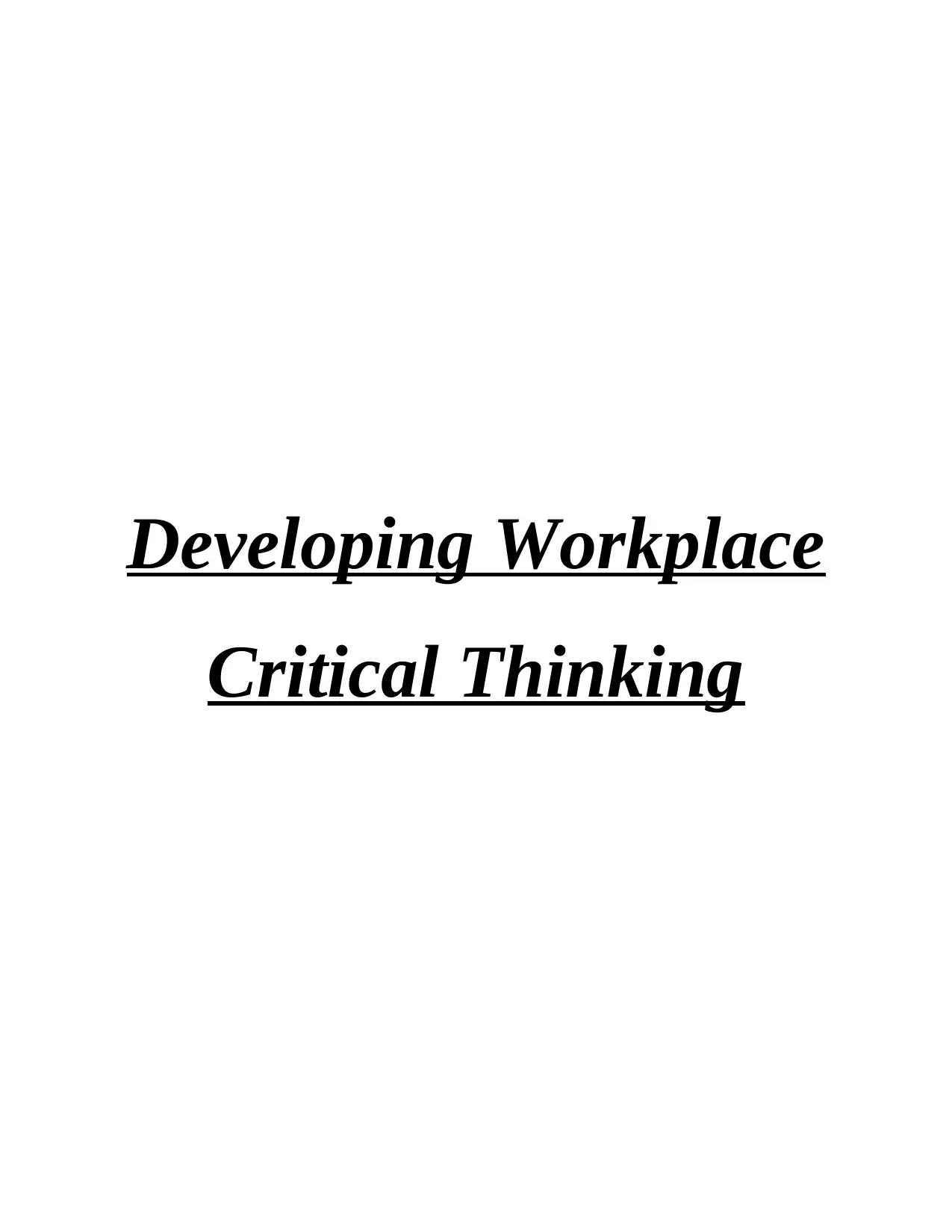
Developing Workplace
Critical Thinking
Critical Thinking
Paraphrase This Document
Need a fresh take? Get an instant paraphrase of this document with our AI Paraphraser

Table of Contents
INTRODUCTION...........................................................................................................................3
Identify and analyse management theories relevant to an organisational example The
Management Theory of Max Weber Describe the theory and critique it...............................3
Critically evaluate its effectiveness in the organisation based on the values and culture of that
organisation............................................................................................................................5
Identify any additional theories that could enhance the organisation’s performance............5
Finally how would you align your personal Values, attitudes and Beliefs with the
organisational example ..........................................................................................................6
Align your personal Values, attitudes and Beliefs with the organisational example used in
your report..............................................................................................................................8
CONCLUSION..............................................................................................................................10
REFERENCES .............................................................................................................................11
INTRODUCTION...........................................................................................................................3
Identify and analyse management theories relevant to an organisational example The
Management Theory of Max Weber Describe the theory and critique it...............................3
Critically evaluate its effectiveness in the organisation based on the values and culture of that
organisation............................................................................................................................5
Identify any additional theories that could enhance the organisation’s performance............5
Finally how would you align your personal Values, attitudes and Beliefs with the
organisational example ..........................................................................................................6
Align your personal Values, attitudes and Beliefs with the organisational example used in
your report..............................................................................................................................8
CONCLUSION..............................................................................................................................10
REFERENCES .............................................................................................................................11
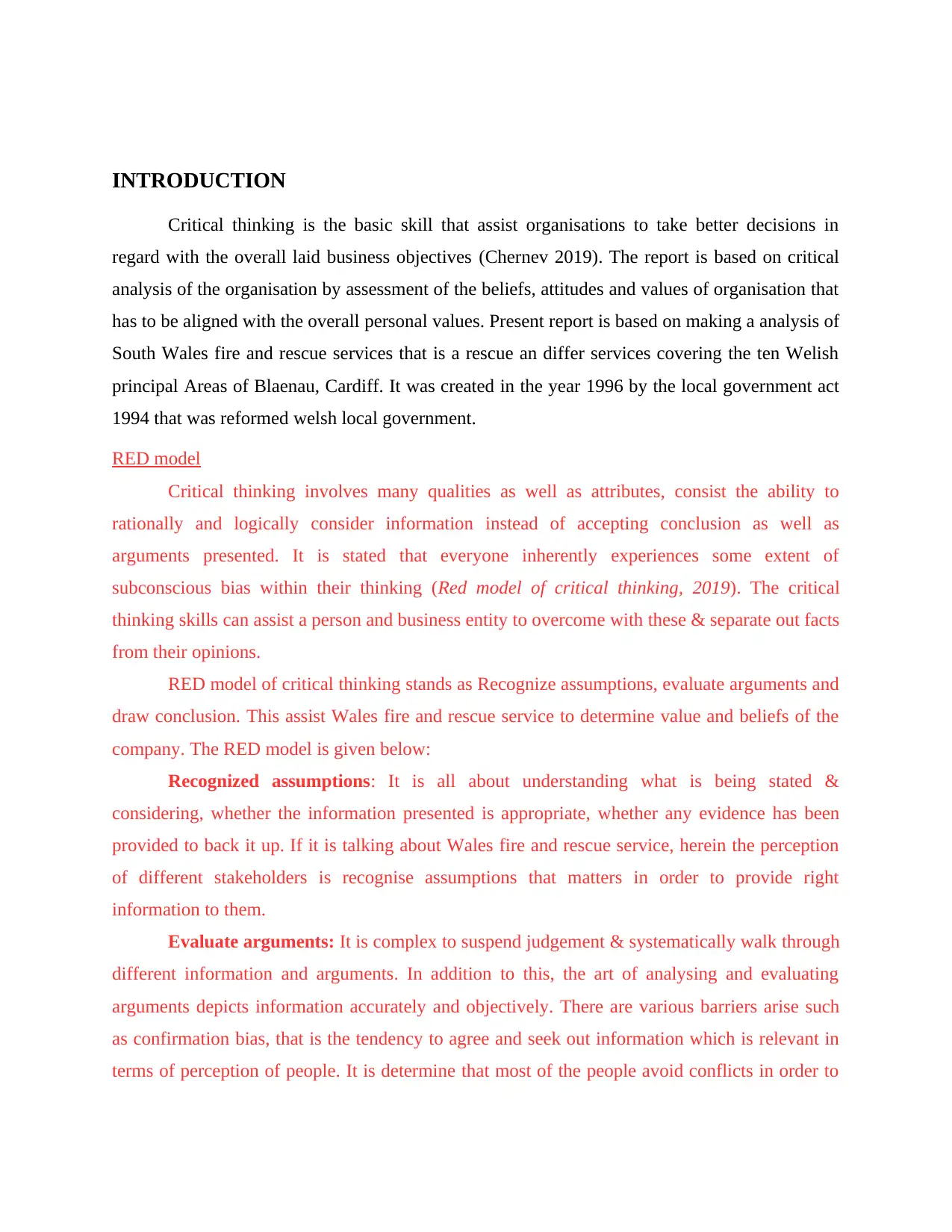
INTRODUCTION
Critical thinking is the basic skill that assist organisations to take better decisions in
regard with the overall laid business objectives (Chernev 2019). The report is based on critical
analysis of the organisation by assessment of the beliefs, attitudes and values of organisation that
has to be aligned with the overall personal values. Present report is based on making a analysis of
South Wales fire and rescue services that is a rescue an differ services covering the ten Welish
principal Areas of Blaenau, Cardiff. It was created in the year 1996 by the local government act
1994 that was reformed welsh local government.
RED model
Critical thinking involves many qualities as well as attributes, consist the ability to
rationally and logically consider information instead of accepting conclusion as well as
arguments presented. It is stated that everyone inherently experiences some extent of
subconscious bias within their thinking (Red model of critical thinking, 2019). The critical
thinking skills can assist a person and business entity to overcome with these & separate out facts
from their opinions.
RED model of critical thinking stands as Recognize assumptions, evaluate arguments and
draw conclusion. This assist Wales fire and rescue service to determine value and beliefs of the
company. The RED model is given below:
Recognized assumptions: It is all about understanding what is being stated &
considering, whether the information presented is appropriate, whether any evidence has been
provided to back it up. If it is talking about Wales fire and rescue service, herein the perception
of different stakeholders is recognise assumptions that matters in order to provide right
information to them.
Evaluate arguments: It is complex to suspend judgement & systematically walk through
different information and arguments. In addition to this, the art of analysing and evaluating
arguments depicts information accurately and objectively. There are various barriers arise such
as confirmation bias, that is the tendency to agree and seek out information which is relevant in
terms of perception of people. It is determine that most of the people avoid conflicts in order to
Critical thinking is the basic skill that assist organisations to take better decisions in
regard with the overall laid business objectives (Chernev 2019). The report is based on critical
analysis of the organisation by assessment of the beliefs, attitudes and values of organisation that
has to be aligned with the overall personal values. Present report is based on making a analysis of
South Wales fire and rescue services that is a rescue an differ services covering the ten Welish
principal Areas of Blaenau, Cardiff. It was created in the year 1996 by the local government act
1994 that was reformed welsh local government.
RED model
Critical thinking involves many qualities as well as attributes, consist the ability to
rationally and logically consider information instead of accepting conclusion as well as
arguments presented. It is stated that everyone inherently experiences some extent of
subconscious bias within their thinking (Red model of critical thinking, 2019). The critical
thinking skills can assist a person and business entity to overcome with these & separate out facts
from their opinions.
RED model of critical thinking stands as Recognize assumptions, evaluate arguments and
draw conclusion. This assist Wales fire and rescue service to determine value and beliefs of the
company. The RED model is given below:
Recognized assumptions: It is all about understanding what is being stated &
considering, whether the information presented is appropriate, whether any evidence has been
provided to back it up. If it is talking about Wales fire and rescue service, herein the perception
of different stakeholders is recognise assumptions that matters in order to provide right
information to them.
Evaluate arguments: It is complex to suspend judgement & systematically walk through
different information and arguments. In addition to this, the art of analysing and evaluating
arguments depicts information accurately and objectively. There are various barriers arise such
as confirmation bias, that is the tendency to agree and seek out information which is relevant in
terms of perception of people. It is determine that most of the people avoid conflicts in order to
⊘ This is a preview!⊘
Do you want full access?
Subscribe today to unlock all pages.

Trusted by 1+ million students worldwide
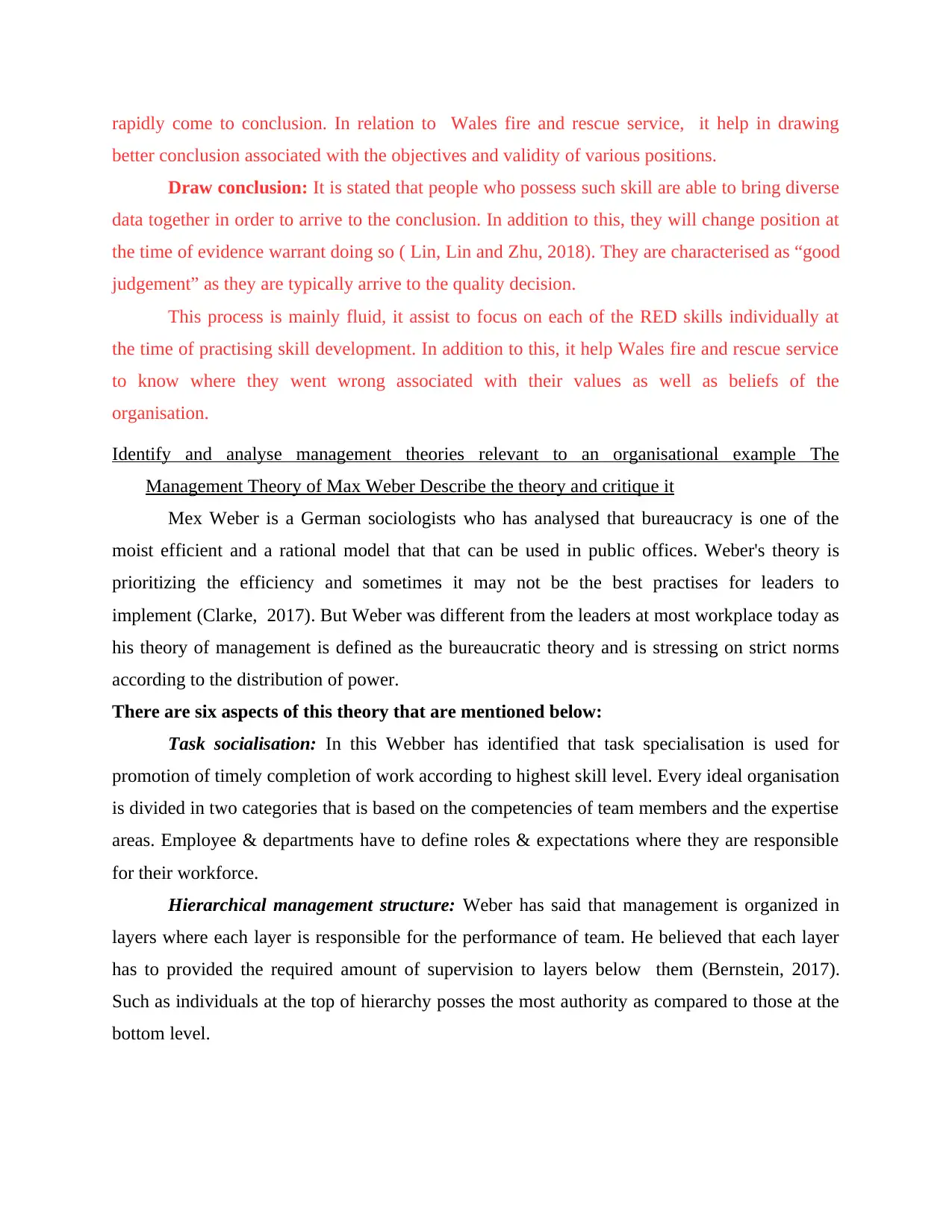
rapidly come to conclusion. In relation to Wales fire and rescue service, it help in drawing
better conclusion associated with the objectives and validity of various positions.
Draw conclusion: It is stated that people who possess such skill are able to bring diverse
data together in order to arrive to the conclusion. In addition to this, they will change position at
the time of evidence warrant doing so ( Lin, Lin and Zhu, 2018). They are characterised as “good
judgement” as they are typically arrive to the quality decision.
This process is mainly fluid, it assist to focus on each of the RED skills individually at
the time of practising skill development. In addition to this, it help Wales fire and rescue service
to know where they went wrong associated with their values as well as beliefs of the
organisation.
Identify and analyse management theories relevant to an organisational example The
Management Theory of Max Weber Describe the theory and critique it
Mex Weber is a German sociologists who has analysed that bureaucracy is one of the
moist efficient and a rational model that that can be used in public offices. Weber's theory is
prioritizing the efficiency and sometimes it may not be the best practises for leaders to
implement (Clarke, 2017). But Weber was different from the leaders at most workplace today as
his theory of management is defined as the bureaucratic theory and is stressing on strict norms
according to the distribution of power.
There are six aspects of this theory that are mentioned below:
Task socialisation: In this Webber has identified that task specialisation is used for
promotion of timely completion of work according to highest skill level. Every ideal organisation
is divided in two categories that is based on the competencies of team members and the expertise
areas. Employee & departments have to define roles & expectations where they are responsible
for their workforce.
Hierarchical management structure: Weber has said that management is organized in
layers where each layer is responsible for the performance of team. He believed that each layer
has to provided the required amount of supervision to layers below them (Bernstein, 2017).
Such as individuals at the top of hierarchy posses the most authority as compared to those at the
bottom level.
better conclusion associated with the objectives and validity of various positions.
Draw conclusion: It is stated that people who possess such skill are able to bring diverse
data together in order to arrive to the conclusion. In addition to this, they will change position at
the time of evidence warrant doing so ( Lin, Lin and Zhu, 2018). They are characterised as “good
judgement” as they are typically arrive to the quality decision.
This process is mainly fluid, it assist to focus on each of the RED skills individually at
the time of practising skill development. In addition to this, it help Wales fire and rescue service
to know where they went wrong associated with their values as well as beliefs of the
organisation.
Identify and analyse management theories relevant to an organisational example The
Management Theory of Max Weber Describe the theory and critique it
Mex Weber is a German sociologists who has analysed that bureaucracy is one of the
moist efficient and a rational model that that can be used in public offices. Weber's theory is
prioritizing the efficiency and sometimes it may not be the best practises for leaders to
implement (Clarke, 2017). But Weber was different from the leaders at most workplace today as
his theory of management is defined as the bureaucratic theory and is stressing on strict norms
according to the distribution of power.
There are six aspects of this theory that are mentioned below:
Task socialisation: In this Webber has identified that task specialisation is used for
promotion of timely completion of work according to highest skill level. Every ideal organisation
is divided in two categories that is based on the competencies of team members and the expertise
areas. Employee & departments have to define roles & expectations where they are responsible
for their workforce.
Hierarchical management structure: Weber has said that management is organized in
layers where each layer is responsible for the performance of team. He believed that each layer
has to provided the required amount of supervision to layers below them (Bernstein, 2017).
Such as individuals at the top of hierarchy posses the most authority as compared to those at the
bottom level.
Paraphrase This Document
Need a fresh take? Get an instant paraphrase of this document with our AI Paraphraser

Formal selection rules: Weber believed that employees have to be selected according to
their present competencies and technical skills that is acquired by experience, education and
training apart from this no other factor has to be considered.
Efficient and uniform requirements: Employees have argued to weber that they must know
what is being expected from them such as in a ideal organisation the rule shave to be clearly
defined. It promotes higher uniformity in he organisation and there is more smoothness (Calás,
and Smircich, 2019). If there is introduction of any new requirements or rules then in this case
the higher level of management and directors are to be responsible to implement them and
further enforce such rules. In Wales fire and rescue services if the new rules have to be change
then it have to be timely reintroduced as high level management that is directors are responsible
for enforcing and then implementation of such rules (Crnkovi and Vukomanović, 2016).
Impersonal environment: In Weber's theory the relationship between employees must be
professional only. As the impersonal environment is characterised by Bureaucracies that is
promoting the decision making based on rational thinking and facts (Merkus and Veenswijk,
2017). It also prevents any type of nepotism or favouritism of outsiders that can affect the
mission of the organisation.
Achievement based advancement: Weber felt that in organisations promotions and any
type of extra benefits that are provided to employees have to be solely based on technical
qualifications, contributions, achievements and experiences (Wolfe and Tubi, 2019). In Wales
fire and rescue services, the management is working towards ensuring that there is no any type
of supernal favours, personality traits or relationships that are being favoured by the top
management to take any type of decisions that are based on personal favours.
Some other characteristics of ideal bureaucracy:
There are some other feature of deal bureaucracy that are mentioned below:
Clearly defined roles: Weber believes that responsibility shave to be delegated based on the
abilities and skills of individuals (Chernev, 2019). In Wales fire and rescue services there are
no flexible roles as employees have to be aware of theory responsibilities by focussing on
disruption of the hierarchy authority theory. There is creative thinking, collaboration and idea
pitching that have to be focussed by employees.
Meticulous record keeping: In this weber explained that Leaders must take notes of each
position, concern or occurrence. In Wales fire and rescue services employers are regularly
their present competencies and technical skills that is acquired by experience, education and
training apart from this no other factor has to be considered.
Efficient and uniform requirements: Employees have argued to weber that they must know
what is being expected from them such as in a ideal organisation the rule shave to be clearly
defined. It promotes higher uniformity in he organisation and there is more smoothness (Calás,
and Smircich, 2019). If there is introduction of any new requirements or rules then in this case
the higher level of management and directors are to be responsible to implement them and
further enforce such rules. In Wales fire and rescue services if the new rules have to be change
then it have to be timely reintroduced as high level management that is directors are responsible
for enforcing and then implementation of such rules (Crnkovi and Vukomanović, 2016).
Impersonal environment: In Weber's theory the relationship between employees must be
professional only. As the impersonal environment is characterised by Bureaucracies that is
promoting the decision making based on rational thinking and facts (Merkus and Veenswijk,
2017). It also prevents any type of nepotism or favouritism of outsiders that can affect the
mission of the organisation.
Achievement based advancement: Weber felt that in organisations promotions and any
type of extra benefits that are provided to employees have to be solely based on technical
qualifications, contributions, achievements and experiences (Wolfe and Tubi, 2019). In Wales
fire and rescue services, the management is working towards ensuring that there is no any type
of supernal favours, personality traits or relationships that are being favoured by the top
management to take any type of decisions that are based on personal favours.
Some other characteristics of ideal bureaucracy:
There are some other feature of deal bureaucracy that are mentioned below:
Clearly defined roles: Weber believes that responsibility shave to be delegated based on the
abilities and skills of individuals (Chernev, 2019). In Wales fire and rescue services there are
no flexible roles as employees have to be aware of theory responsibilities by focussing on
disruption of the hierarchy authority theory. There is creative thinking, collaboration and idea
pitching that have to be focussed by employees.
Meticulous record keeping: In this weber explained that Leaders must take notes of each
position, concern or occurrence. In Wales fire and rescue services employers are regularly
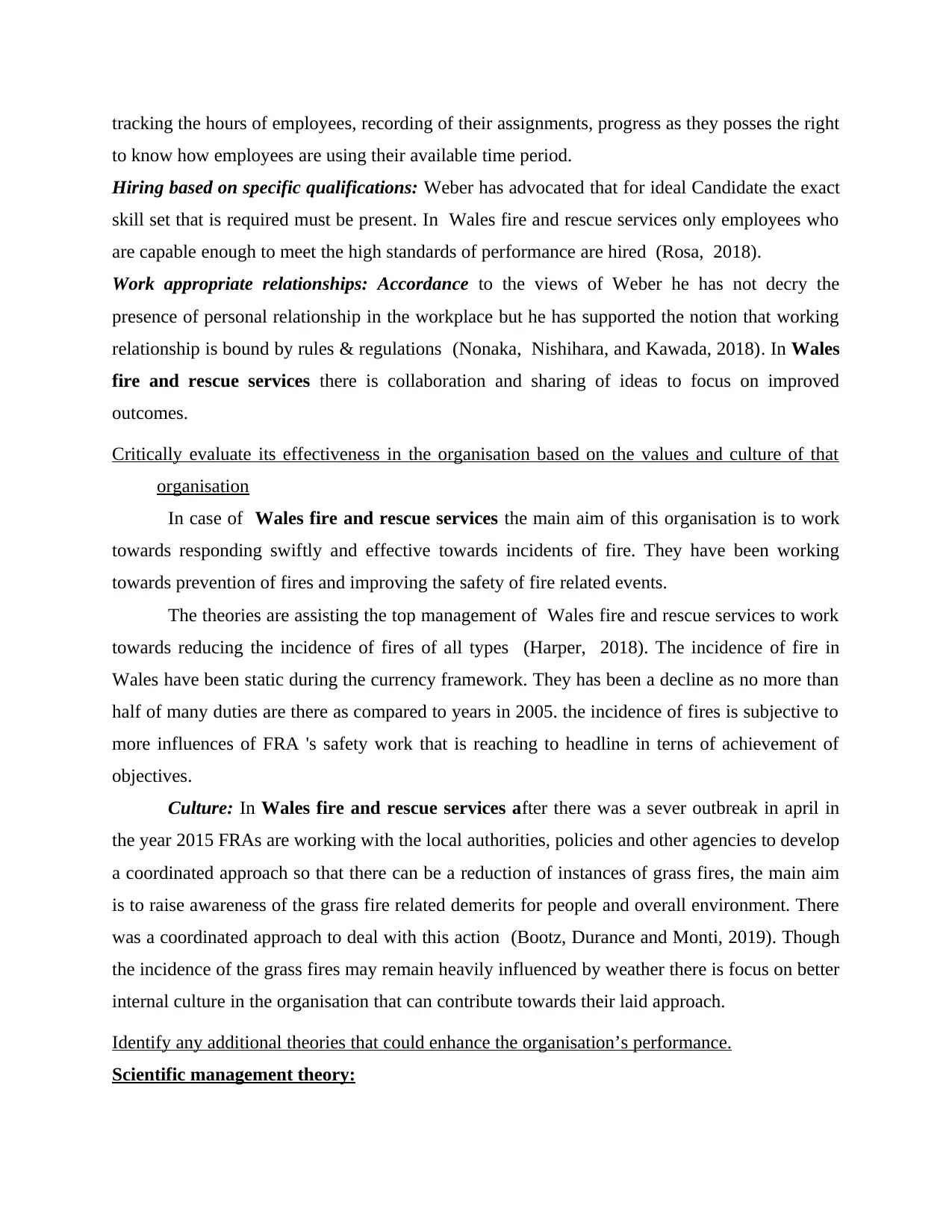
tracking the hours of employees, recording of their assignments, progress as they posses the right
to know how employees are using their available time period.
Hiring based on specific qualifications: Weber has advocated that for ideal Candidate the exact
skill set that is required must be present. In Wales fire and rescue services only employees who
are capable enough to meet the high standards of performance are hired (Rosa, 2018).
Work appropriate relationships: Accordance to the views of Weber he has not decry the
presence of personal relationship in the workplace but he has supported the notion that working
relationship is bound by rules & regulations (Nonaka, Nishihara, and Kawada, 2018). In Wales
fire and rescue services there is collaboration and sharing of ideas to focus on improved
outcomes.
Critically evaluate its effectiveness in the organisation based on the values and culture of that
organisation
In case of Wales fire and rescue services the main aim of this organisation is to work
towards responding swiftly and effective towards incidents of fire. They have been working
towards prevention of fires and improving the safety of fire related events.
The theories are assisting the top management of Wales fire and rescue services to work
towards reducing the incidence of fires of all types (Harper, 2018). The incidence of fire in
Wales have been static during the currency framework. They has been a decline as no more than
half of many duties are there as compared to years in 2005. the incidence of fires is subjective to
more influences of FRA 's safety work that is reaching to headline in terns of achievement of
objectives.
Culture: In Wales fire and rescue services after there was a sever outbreak in april in
the year 2015 FRAs are working with the local authorities, policies and other agencies to develop
a coordinated approach so that there can be a reduction of instances of grass fires, the main aim
is to raise awareness of the grass fire related demerits for people and overall environment. There
was a coordinated approach to deal with this action (Bootz, Durance and Monti, 2019). Though
the incidence of the grass fires may remain heavily influenced by weather there is focus on better
internal culture in the organisation that can contribute towards their laid approach.
Identify any additional theories that could enhance the organisation’s performance.
Scientific management theory:
to know how employees are using their available time period.
Hiring based on specific qualifications: Weber has advocated that for ideal Candidate the exact
skill set that is required must be present. In Wales fire and rescue services only employees who
are capable enough to meet the high standards of performance are hired (Rosa, 2018).
Work appropriate relationships: Accordance to the views of Weber he has not decry the
presence of personal relationship in the workplace but he has supported the notion that working
relationship is bound by rules & regulations (Nonaka, Nishihara, and Kawada, 2018). In Wales
fire and rescue services there is collaboration and sharing of ideas to focus on improved
outcomes.
Critically evaluate its effectiveness in the organisation based on the values and culture of that
organisation
In case of Wales fire and rescue services the main aim of this organisation is to work
towards responding swiftly and effective towards incidents of fire. They have been working
towards prevention of fires and improving the safety of fire related events.
The theories are assisting the top management of Wales fire and rescue services to work
towards reducing the incidence of fires of all types (Harper, 2018). The incidence of fire in
Wales have been static during the currency framework. They has been a decline as no more than
half of many duties are there as compared to years in 2005. the incidence of fires is subjective to
more influences of FRA 's safety work that is reaching to headline in terns of achievement of
objectives.
Culture: In Wales fire and rescue services after there was a sever outbreak in april in
the year 2015 FRAs are working with the local authorities, policies and other agencies to develop
a coordinated approach so that there can be a reduction of instances of grass fires, the main aim
is to raise awareness of the grass fire related demerits for people and overall environment. There
was a coordinated approach to deal with this action (Bootz, Durance and Monti, 2019). Though
the incidence of the grass fires may remain heavily influenced by weather there is focus on better
internal culture in the organisation that can contribute towards their laid approach.
Identify any additional theories that could enhance the organisation’s performance.
Scientific management theory:
⊘ This is a preview!⊘
Do you want full access?
Subscribe today to unlock all pages.

Trusted by 1+ million students worldwide
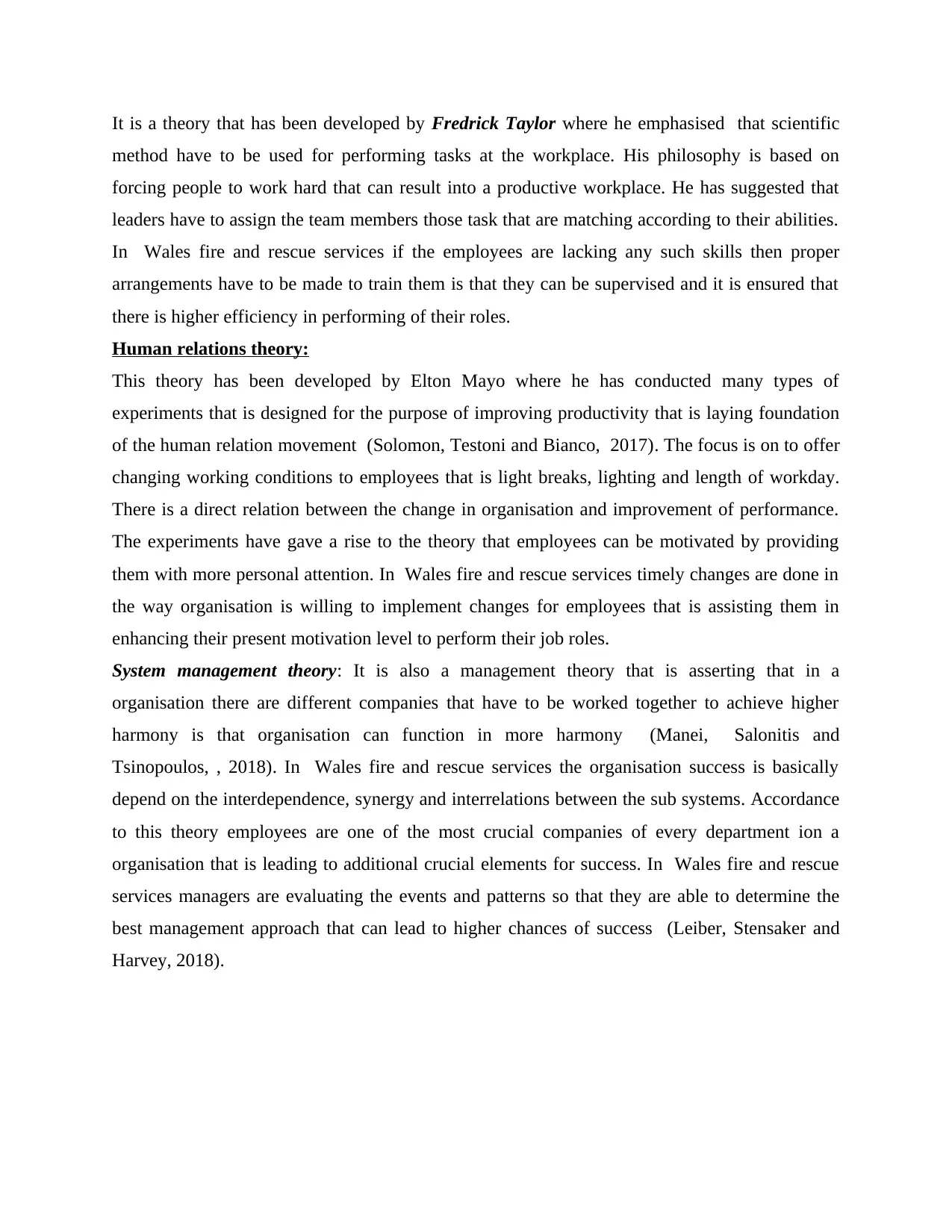
It is a theory that has been developed by Fredrick Taylor where he emphasised that scientific
method have to be used for performing tasks at the workplace. His philosophy is based on
forcing people to work hard that can result into a productive workplace. He has suggested that
leaders have to assign the team members those task that are matching according to their abilities.
In Wales fire and rescue services if the employees are lacking any such skills then proper
arrangements have to be made to train them is that they can be supervised and it is ensured that
there is higher efficiency in performing of their roles.
Human relations theory:
This theory has been developed by Elton Mayo where he has conducted many types of
experiments that is designed for the purpose of improving productivity that is laying foundation
of the human relation movement (Solomon, Testoni and Bianco, 2017). The focus is on to offer
changing working conditions to employees that is light breaks, lighting and length of workday.
There is a direct relation between the change in organisation and improvement of performance.
The experiments have gave a rise to the theory that employees can be motivated by providing
them with more personal attention. In Wales fire and rescue services timely changes are done in
the way organisation is willing to implement changes for employees that is assisting them in
enhancing their present motivation level to perform their job roles.
System management theory: It is also a management theory that is asserting that in a
organisation there are different companies that have to be worked together to achieve higher
harmony is that organisation can function in more harmony (Manei, Salonitis and
Tsinopoulos, , 2018). In Wales fire and rescue services the organisation success is basically
depend on the interdependence, synergy and interrelations between the sub systems. Accordance
to this theory employees are one of the most crucial companies of every department ion a
organisation that is leading to additional crucial elements for success. In Wales fire and rescue
services managers are evaluating the events and patterns so that they are able to determine the
best management approach that can lead to higher chances of success (Leiber, Stensaker and
Harvey, 2018).
method have to be used for performing tasks at the workplace. His philosophy is based on
forcing people to work hard that can result into a productive workplace. He has suggested that
leaders have to assign the team members those task that are matching according to their abilities.
In Wales fire and rescue services if the employees are lacking any such skills then proper
arrangements have to be made to train them is that they can be supervised and it is ensured that
there is higher efficiency in performing of their roles.
Human relations theory:
This theory has been developed by Elton Mayo where he has conducted many types of
experiments that is designed for the purpose of improving productivity that is laying foundation
of the human relation movement (Solomon, Testoni and Bianco, 2017). The focus is on to offer
changing working conditions to employees that is light breaks, lighting and length of workday.
There is a direct relation between the change in organisation and improvement of performance.
The experiments have gave a rise to the theory that employees can be motivated by providing
them with more personal attention. In Wales fire and rescue services timely changes are done in
the way organisation is willing to implement changes for employees that is assisting them in
enhancing their present motivation level to perform their job roles.
System management theory: It is also a management theory that is asserting that in a
organisation there are different companies that have to be worked together to achieve higher
harmony is that organisation can function in more harmony (Manei, Salonitis and
Tsinopoulos, , 2018). In Wales fire and rescue services the organisation success is basically
depend on the interdependence, synergy and interrelations between the sub systems. Accordance
to this theory employees are one of the most crucial companies of every department ion a
organisation that is leading to additional crucial elements for success. In Wales fire and rescue
services managers are evaluating the events and patterns so that they are able to determine the
best management approach that can lead to higher chances of success (Leiber, Stensaker and
Harvey, 2018).
Paraphrase This Document
Need a fresh take? Get an instant paraphrase of this document with our AI Paraphraser

Finally how would you align your personal Values, attitudes and Beliefs with the organisational
example
There is alignment of personal values of employees in a ingratiation with a overall values
of the organisation. In Wales fire and rescue services the core values of the organisation is
lying with the aspects of promoting fire safety, responding to road traffic and fire fighting so that
there can be responding to road traffic indicates and other types of fire related emergencies.
Fire and rescue services act is the main legislation that is governing this organisation. There is
provision related to the constitution and functions of fire fighters employment, rescue authorities
and other related matters (Routledge and Vess, 2018). The legislation is very relevant to focus
on fire & rescue related services in Wales that is part of “key legislation”. The law is related to
devolving of national assembles of Wales,.
Governance standards:
Good governance is a very essential tool for the purpose of having a better management
in a public sector organisation. There is focus on public debate, challenge and scrutiny in Wales
fire and rescue services that is generating the Valenzuela information about the experiences and
people expectation about the services of Wales fire and rescue services. There have been some
of the issues that are faced by the general public subclause of internal in efficiency that includes.
Fire and rescue services are concern with regards that have to be controlled with proper internal
management so that there can be clear roles that can be served.
These issues can be solved with proper application of some of the management theories
that includes the Theory X and Y. according to the social psychologist, Douglas McGregor, he
introduced this theory in the book “Human side of the enterprise” where he focussed that there
can be used of two different styles of management that is guided bu the perceptions of team
members and their overall motivation level (Bratton, and Gold, 2017). Managers are assuming
that employees are committed, self motivated and responsible. This leads to a more collaborative
work scenario. On the other hand the Theory X there is micro managing where organisation may
realise of theory X so that everyone is focussed on meeting of the gaols of organisations. In Fire
and rescue services being a large public organisation there is relying on use of theory X so that
whole the workforce can be focussed on meeting of the laid goals. It leads to better decision
making and higher creativity in the course of decision making process.
Contingency management theory:
example
There is alignment of personal values of employees in a ingratiation with a overall values
of the organisation. In Wales fire and rescue services the core values of the organisation is
lying with the aspects of promoting fire safety, responding to road traffic and fire fighting so that
there can be responding to road traffic indicates and other types of fire related emergencies.
Fire and rescue services act is the main legislation that is governing this organisation. There is
provision related to the constitution and functions of fire fighters employment, rescue authorities
and other related matters (Routledge and Vess, 2018). The legislation is very relevant to focus
on fire & rescue related services in Wales that is part of “key legislation”. The law is related to
devolving of national assembles of Wales,.
Governance standards:
Good governance is a very essential tool for the purpose of having a better management
in a public sector organisation. There is focus on public debate, challenge and scrutiny in Wales
fire and rescue services that is generating the Valenzuela information about the experiences and
people expectation about the services of Wales fire and rescue services. There have been some
of the issues that are faced by the general public subclause of internal in efficiency that includes.
Fire and rescue services are concern with regards that have to be controlled with proper internal
management so that there can be clear roles that can be served.
These issues can be solved with proper application of some of the management theories
that includes the Theory X and Y. according to the social psychologist, Douglas McGregor, he
introduced this theory in the book “Human side of the enterprise” where he focussed that there
can be used of two different styles of management that is guided bu the perceptions of team
members and their overall motivation level (Bratton, and Gold, 2017). Managers are assuming
that employees are committed, self motivated and responsible. This leads to a more collaborative
work scenario. On the other hand the Theory X there is micro managing where organisation may
realise of theory X so that everyone is focussed on meeting of the gaols of organisations. In Fire
and rescue services being a large public organisation there is relying on use of theory X so that
whole the workforce can be focussed on meeting of the laid goals. It leads to better decision
making and higher creativity in the course of decision making process.
Contingency management theory:
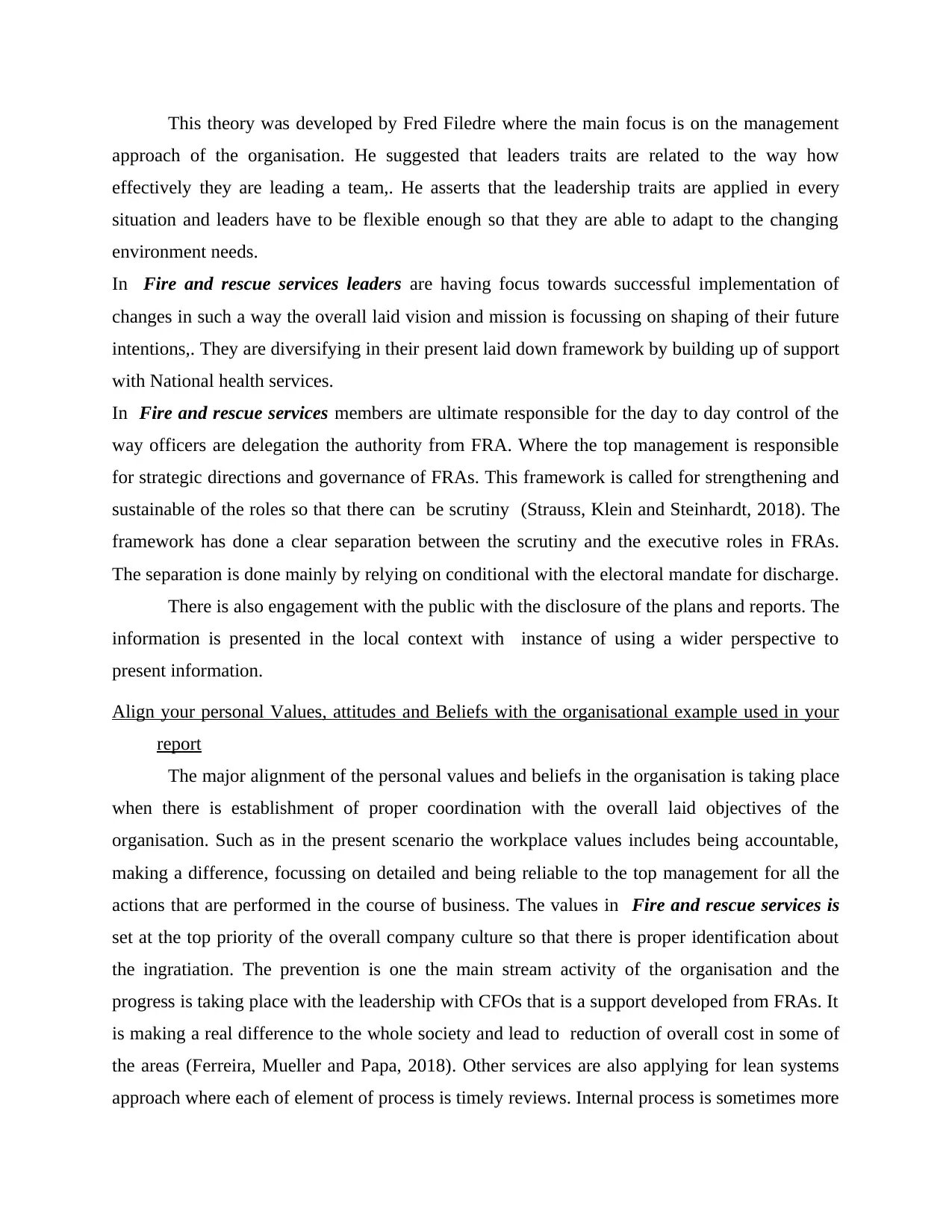
This theory was developed by Fred Filedre where the main focus is on the management
approach of the organisation. He suggested that leaders traits are related to the way how
effectively they are leading a team,. He asserts that the leadership traits are applied in every
situation and leaders have to be flexible enough so that they are able to adapt to the changing
environment needs.
In Fire and rescue services leaders are having focus towards successful implementation of
changes in such a way the overall laid vision and mission is focussing on shaping of their future
intentions,. They are diversifying in their present laid down framework by building up of support
with National health services.
In Fire and rescue services members are ultimate responsible for the day to day control of the
way officers are delegation the authority from FRA. Where the top management is responsible
for strategic directions and governance of FRAs. This framework is called for strengthening and
sustainable of the roles so that there can be scrutiny (Strauss, Klein and Steinhardt, 2018). The
framework has done a clear separation between the scrutiny and the executive roles in FRAs.
The separation is done mainly by relying on conditional with the electoral mandate for discharge.
There is also engagement with the public with the disclosure of the plans and reports. The
information is presented in the local context with instance of using a wider perspective to
present information.
Align your personal Values, attitudes and Beliefs with the organisational example used in your
report
The major alignment of the personal values and beliefs in the organisation is taking place
when there is establishment of proper coordination with the overall laid objectives of the
organisation. Such as in the present scenario the workplace values includes being accountable,
making a difference, focussing on detailed and being reliable to the top management for all the
actions that are performed in the course of business. The values in Fire and rescue services is
set at the top priority of the overall company culture so that there is proper identification about
the ingratiation. The prevention is one the main stream activity of the organisation and the
progress is taking place with the leadership with CFOs that is a support developed from FRAs. It
is making a real difference to the whole society and lead to reduction of overall cost in some of
the areas (Ferreira, Mueller and Papa, 2018). Other services are also applying for lean systems
approach where each of element of process is timely reviews. Internal process is sometimes more
approach of the organisation. He suggested that leaders traits are related to the way how
effectively they are leading a team,. He asserts that the leadership traits are applied in every
situation and leaders have to be flexible enough so that they are able to adapt to the changing
environment needs.
In Fire and rescue services leaders are having focus towards successful implementation of
changes in such a way the overall laid vision and mission is focussing on shaping of their future
intentions,. They are diversifying in their present laid down framework by building up of support
with National health services.
In Fire and rescue services members are ultimate responsible for the day to day control of the
way officers are delegation the authority from FRA. Where the top management is responsible
for strategic directions and governance of FRAs. This framework is called for strengthening and
sustainable of the roles so that there can be scrutiny (Strauss, Klein and Steinhardt, 2018). The
framework has done a clear separation between the scrutiny and the executive roles in FRAs.
The separation is done mainly by relying on conditional with the electoral mandate for discharge.
There is also engagement with the public with the disclosure of the plans and reports. The
information is presented in the local context with instance of using a wider perspective to
present information.
Align your personal Values, attitudes and Beliefs with the organisational example used in your
report
The major alignment of the personal values and beliefs in the organisation is taking place
when there is establishment of proper coordination with the overall laid objectives of the
organisation. Such as in the present scenario the workplace values includes being accountable,
making a difference, focussing on detailed and being reliable to the top management for all the
actions that are performed in the course of business. The values in Fire and rescue services is
set at the top priority of the overall company culture so that there is proper identification about
the ingratiation. The prevention is one the main stream activity of the organisation and the
progress is taking place with the leadership with CFOs that is a support developed from FRAs. It
is making a real difference to the whole society and lead to reduction of overall cost in some of
the areas (Ferreira, Mueller and Papa, 2018). Other services are also applying for lean systems
approach where each of element of process is timely reviews. Internal process is sometimes more
⊘ This is a preview!⊘
Do you want full access?
Subscribe today to unlock all pages.

Trusted by 1+ million students worldwide
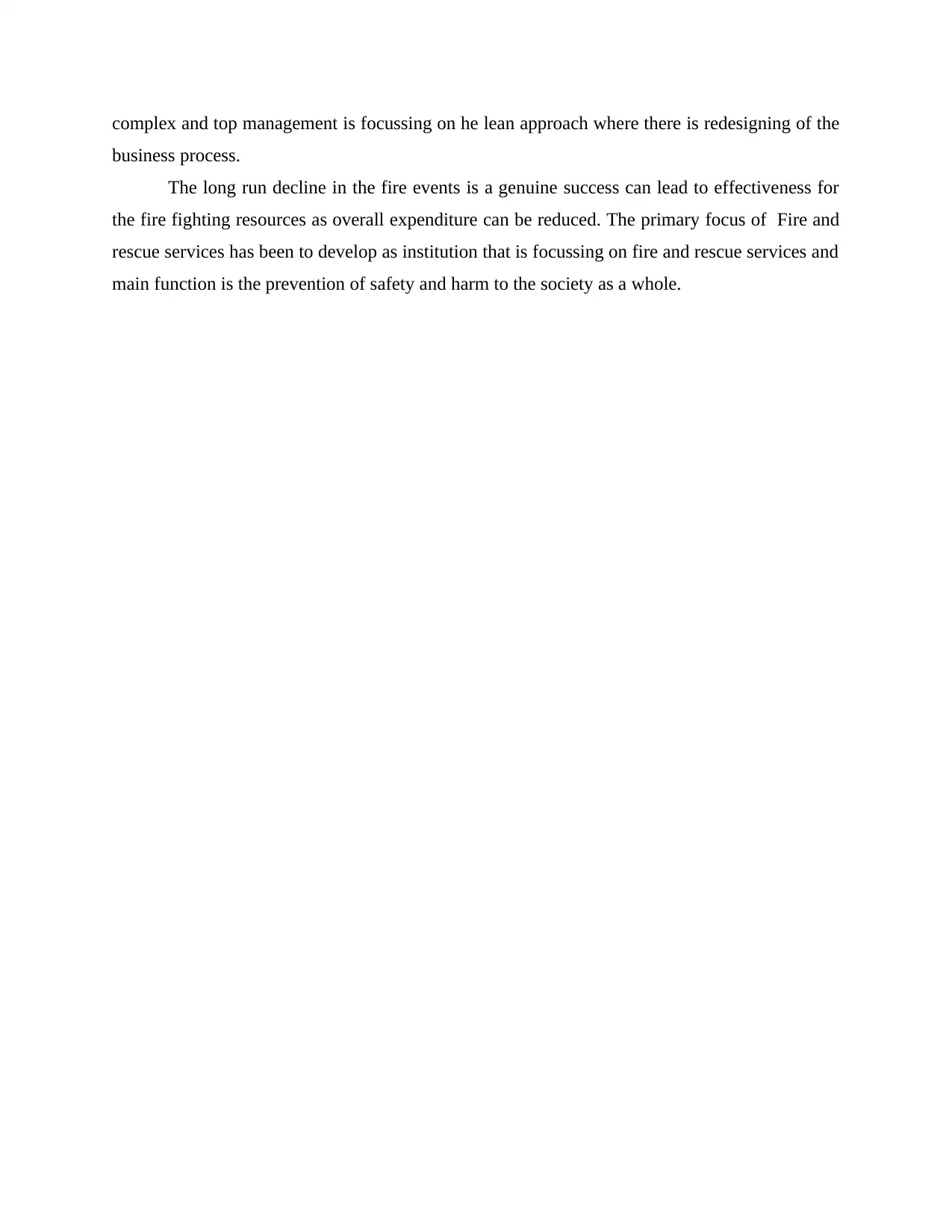
complex and top management is focussing on he lean approach where there is redesigning of the
business process.
The long run decline in the fire events is a genuine success can lead to effectiveness for
the fire fighting resources as overall expenditure can be reduced. The primary focus of Fire and
rescue services has been to develop as institution that is focussing on fire and rescue services and
main function is the prevention of safety and harm to the society as a whole.
business process.
The long run decline in the fire events is a genuine success can lead to effectiveness for
the fire fighting resources as overall expenditure can be reduced. The primary focus of Fire and
rescue services has been to develop as institution that is focussing on fire and rescue services and
main function is the prevention of safety and harm to the society as a whole.
Paraphrase This Document
Need a fresh take? Get an instant paraphrase of this document with our AI Paraphraser
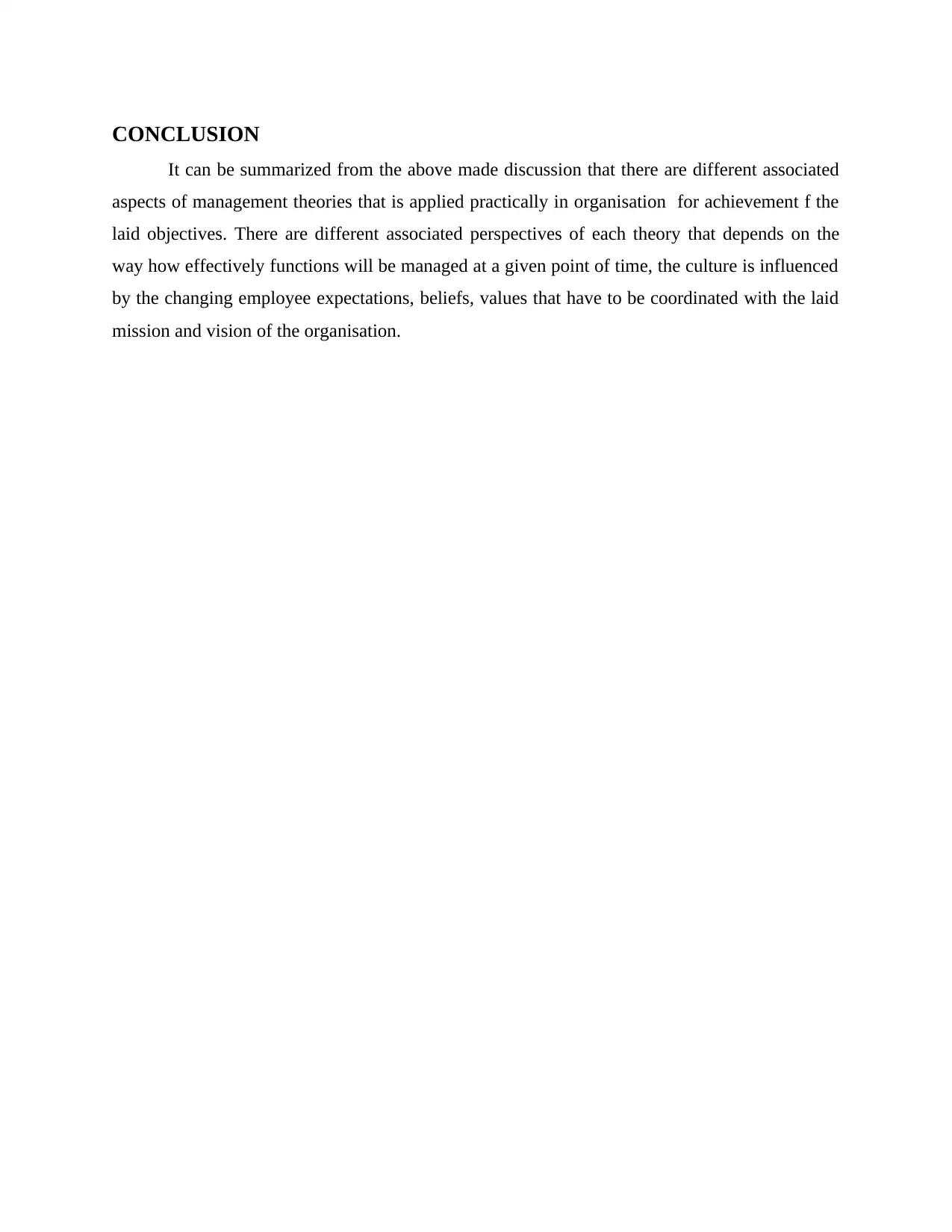
CONCLUSION
It can be summarized from the above made discussion that there are different associated
aspects of management theories that is applied practically in organisation for achievement f the
laid objectives. There are different associated perspectives of each theory that depends on the
way how effectively functions will be managed at a given point of time, the culture is influenced
by the changing employee expectations, beliefs, values that have to be coordinated with the laid
mission and vision of the organisation.
It can be summarized from the above made discussion that there are different associated
aspects of management theories that is applied practically in organisation for achievement f the
laid objectives. There are different associated perspectives of each theory that depends on the
way how effectively functions will be managed at a given point of time, the culture is influenced
by the changing employee expectations, beliefs, values that have to be coordinated with the laid
mission and vision of the organisation.
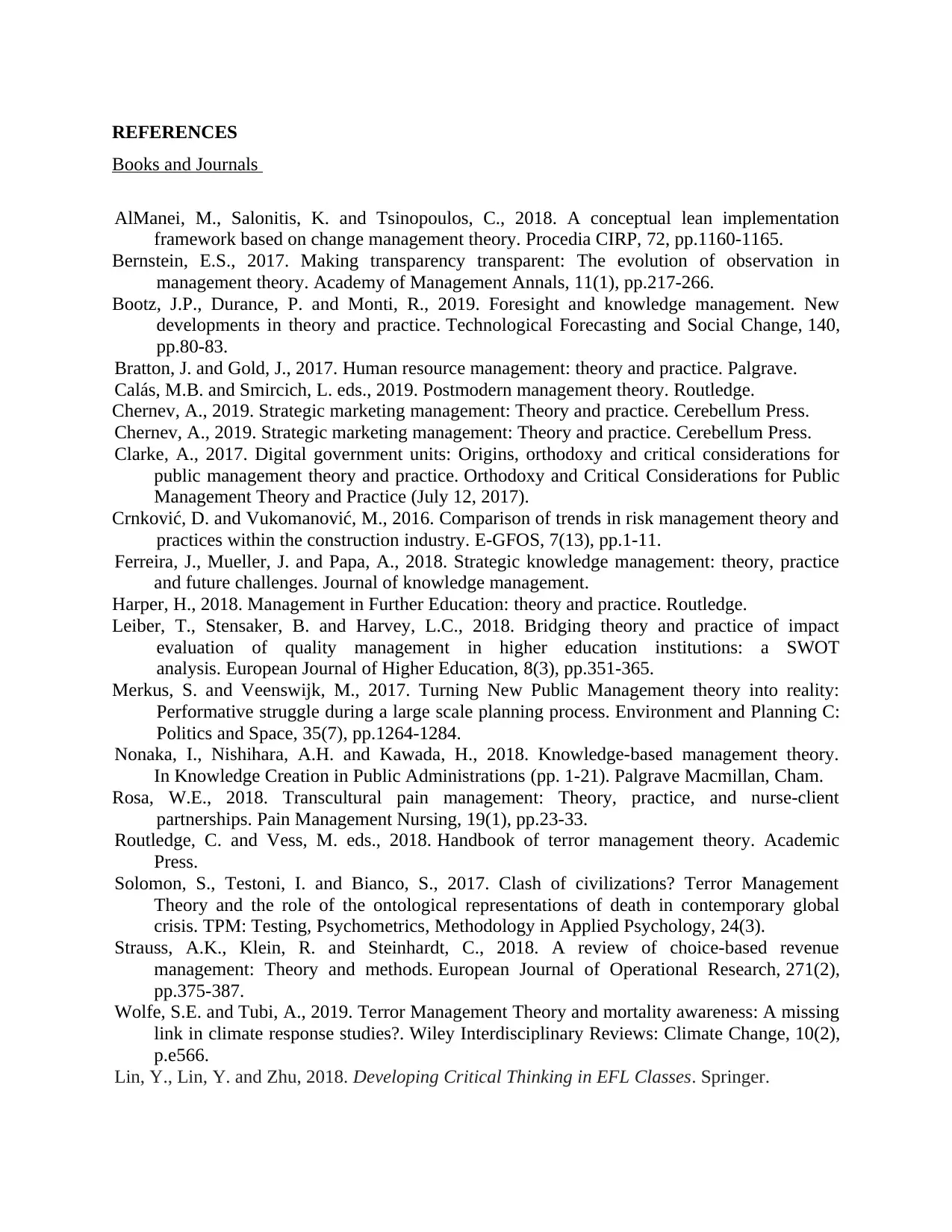
REFERENCES
Books and Journals
AlManei, M., Salonitis, K. and Tsinopoulos, C., 2018. A conceptual lean implementation
framework based on change management theory. Procedia CIRP, 72, pp.1160-1165.
Bernstein, E.S., 2017. Making transparency transparent: The evolution of observation in
management theory. Academy of Management Annals, 11(1), pp.217-266.
Bootz, J.P., Durance, P. and Monti, R., 2019. Foresight and knowledge management. New
developments in theory and practice. Technological Forecasting and Social Change, 140,
pp.80-83.
Bratton, J. and Gold, J., 2017. Human resource management: theory and practice. Palgrave.
Calás, M.B. and Smircich, L. eds., 2019. Postmodern management theory. Routledge.
Chernev, A., 2019. Strategic marketing management: Theory and practice. Cerebellum Press.
Chernev, A., 2019. Strategic marketing management: Theory and practice. Cerebellum Press.
Clarke, A., 2017. Digital government units: Origins, orthodoxy and critical considerations for
public management theory and practice. Orthodoxy and Critical Considerations for Public
Management Theory and Practice (July 12, 2017).
Crnković, D. and Vukomanović, M., 2016. Comparison of trends in risk management theory and
practices within the construction industry. E-GFOS, 7(13), pp.1-11.
Ferreira, J., Mueller, J. and Papa, A., 2018. Strategic knowledge management: theory, practice
and future challenges. Journal of knowledge management.
Harper, H., 2018. Management in Further Education: theory and practice. Routledge.
Leiber, T., Stensaker, B. and Harvey, L.C., 2018. Bridging theory and practice of impact
evaluation of quality management in higher education institutions: a SWOT
analysis. European Journal of Higher Education, 8(3), pp.351-365.
Merkus, S. and Veenswijk, M., 2017. Turning New Public Management theory into reality:
Performative struggle during a large scale planning process. Environment and Planning C:
Politics and Space, 35(7), pp.1264-1284.
Nonaka, I., Nishihara, A.H. and Kawada, H., 2018. Knowledge-based management theory.
In Knowledge Creation in Public Administrations (pp. 1-21). Palgrave Macmillan, Cham.
Rosa, W.E., 2018. Transcultural pain management: Theory, practice, and nurse-client
partnerships. Pain Management Nursing, 19(1), pp.23-33.
Routledge, C. and Vess, M. eds., 2018. Handbook of terror management theory. Academic
Press.
Solomon, S., Testoni, I. and Bianco, S., 2017. Clash of civilizations? Terror Management
Theory and the role of the ontological representations of death in contemporary global
crisis. TPM: Testing, Psychometrics, Methodology in Applied Psychology, 24(3).
Strauss, A.K., Klein, R. and Steinhardt, C., 2018. A review of choice-based revenue
management: Theory and methods. European Journal of Operational Research, 271(2),
pp.375-387.
Wolfe, S.E. and Tubi, A., 2019. Terror Management Theory and mortality awareness: A missing
link in climate response studies?. Wiley Interdisciplinary Reviews: Climate Change, 10(2),
p.e566.
Lin, Y., Lin, Y. and Zhu, 2018. Developing Critical Thinking in EFL Classes. Springer.
Books and Journals
AlManei, M., Salonitis, K. and Tsinopoulos, C., 2018. A conceptual lean implementation
framework based on change management theory. Procedia CIRP, 72, pp.1160-1165.
Bernstein, E.S., 2017. Making transparency transparent: The evolution of observation in
management theory. Academy of Management Annals, 11(1), pp.217-266.
Bootz, J.P., Durance, P. and Monti, R., 2019. Foresight and knowledge management. New
developments in theory and practice. Technological Forecasting and Social Change, 140,
pp.80-83.
Bratton, J. and Gold, J., 2017. Human resource management: theory and practice. Palgrave.
Calás, M.B. and Smircich, L. eds., 2019. Postmodern management theory. Routledge.
Chernev, A., 2019. Strategic marketing management: Theory and practice. Cerebellum Press.
Chernev, A., 2019. Strategic marketing management: Theory and practice. Cerebellum Press.
Clarke, A., 2017. Digital government units: Origins, orthodoxy and critical considerations for
public management theory and practice. Orthodoxy and Critical Considerations for Public
Management Theory and Practice (July 12, 2017).
Crnković, D. and Vukomanović, M., 2016. Comparison of trends in risk management theory and
practices within the construction industry. E-GFOS, 7(13), pp.1-11.
Ferreira, J., Mueller, J. and Papa, A., 2018. Strategic knowledge management: theory, practice
and future challenges. Journal of knowledge management.
Harper, H., 2018. Management in Further Education: theory and practice. Routledge.
Leiber, T., Stensaker, B. and Harvey, L.C., 2018. Bridging theory and practice of impact
evaluation of quality management in higher education institutions: a SWOT
analysis. European Journal of Higher Education, 8(3), pp.351-365.
Merkus, S. and Veenswijk, M., 2017. Turning New Public Management theory into reality:
Performative struggle during a large scale planning process. Environment and Planning C:
Politics and Space, 35(7), pp.1264-1284.
Nonaka, I., Nishihara, A.H. and Kawada, H., 2018. Knowledge-based management theory.
In Knowledge Creation in Public Administrations (pp. 1-21). Palgrave Macmillan, Cham.
Rosa, W.E., 2018. Transcultural pain management: Theory, practice, and nurse-client
partnerships. Pain Management Nursing, 19(1), pp.23-33.
Routledge, C. and Vess, M. eds., 2018. Handbook of terror management theory. Academic
Press.
Solomon, S., Testoni, I. and Bianco, S., 2017. Clash of civilizations? Terror Management
Theory and the role of the ontological representations of death in contemporary global
crisis. TPM: Testing, Psychometrics, Methodology in Applied Psychology, 24(3).
Strauss, A.K., Klein, R. and Steinhardt, C., 2018. A review of choice-based revenue
management: Theory and methods. European Journal of Operational Research, 271(2),
pp.375-387.
Wolfe, S.E. and Tubi, A., 2019. Terror Management Theory and mortality awareness: A missing
link in climate response studies?. Wiley Interdisciplinary Reviews: Climate Change, 10(2),
p.e566.
Lin, Y., Lin, Y. and Zhu, 2018. Developing Critical Thinking in EFL Classes. Springer.
⊘ This is a preview!⊘
Do you want full access?
Subscribe today to unlock all pages.

Trusted by 1+ million students worldwide
1 out of 18
Related Documents
Your All-in-One AI-Powered Toolkit for Academic Success.
+13062052269
info@desklib.com
Available 24*7 on WhatsApp / Email
![[object Object]](/_next/static/media/star-bottom.7253800d.svg)
Unlock your academic potential
Copyright © 2020–2025 A2Z Services. All Rights Reserved. Developed and managed by ZUCOL.



